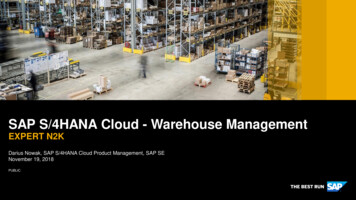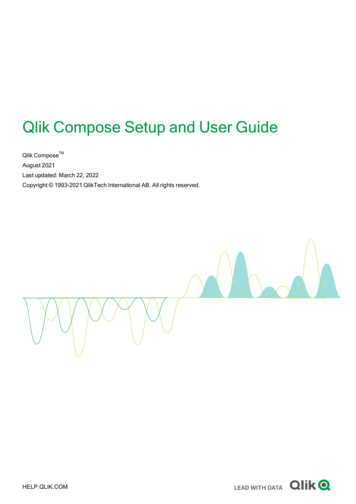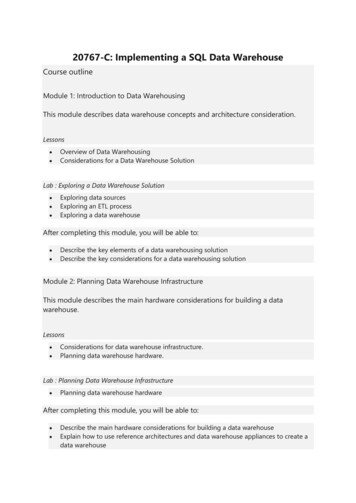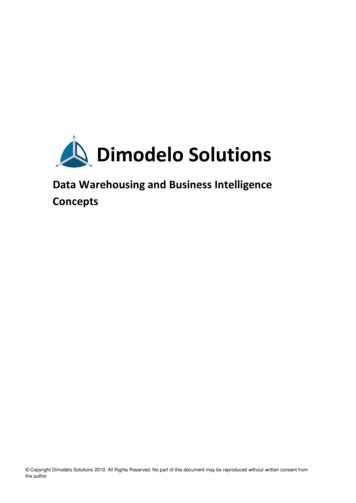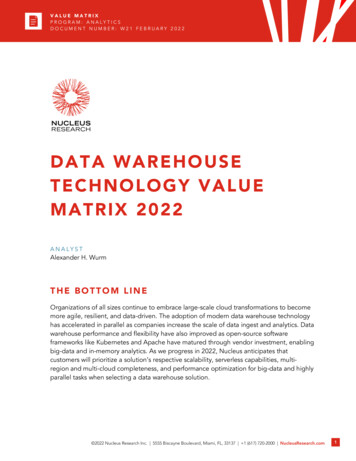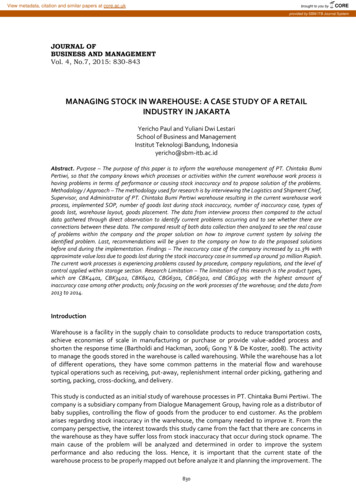
Transcription
View metadata, citation and similar papers at core.ac.ukbrought to you byCOREprovided by SBM ITB Journal SystemJOURNAL OFBUSINESS AND MANAGEMENTVol. 4, No.7, 2015: 830-843MANAGING STOCK IN WAREHOUSE: A CASE STUDY OF A RETAILINDUSTRY IN JAKARTAYericho Paul and Yuliani Dwi LestariSchool of Business and ManagementInstitut Teknologi Bandung, Indonesiayericho@sbm-itb.ac.idAbstract. Purpose – The purpose of this paper is to inform the warehouse management of PT. Chintaka BumiPertiwi, so that the company knows which processes or activities within the current warehouse work process ishaving problems in terms of performance or causing stock inaccuracy and to propose solution of the problems.Methodology / Approach – The methodology used for research is by interviewing the Logistics and Shipment Chief,Supervisor, and Administrator of PT. Chintaka Bumi Pertiwi warehouse resulting in the current warehouse workprocess, implemented SOP, number of goods lost during stock inaccuracy, number of inaccuracy case, types ofgoods lost, warehouse layout, goods placement. The data from interview process then compared to the actualdata gathered through direct observation to identify current problems occurring and to see whether there areconnections between these data. The compared result of both data collection then analyzed to see the real causeof problems within the company and the proper solution on how to improve current system by solving theidentified problem. Last, recommendations will be given to the company on how to do the proposed solutionsbefore and during the implementation. Findings – The inaccuracy case of the company increased by 11.3% withapproximate value loss due to goods lost during the stock inaccuracy case in summed up around 30 million Rupiah.The current work processes is experiencing problems caused by procedure, company regulations, and the level ofcontrol applied within storage section. Research Limitation – The limitation of this research is the product types,which are CBK4401, CBK3402, CBK6402, CBG6301, CBG6302, and CBG1305 with the highest amount ofinaccuracy case among other products; only focusing on the work processes of the warehouse; and the data from2013 to 2014.IntroductionWarehouse is a facility in the supply chain to consolidate products to reduce transportation costs,achieve economies of scale in manufacturing or purchase or provide value-added process andshorten the response time (Bartholdi and Hackman, 2006; Gong Y & De Koster, 2008). The activityto manage the goods stored in the warehouse is called warehousing. While the warehouse has a lotof different operations, they have some common patterns in the material flow and warehousetypical operations such as receiving, put-away, replenishment internal order picking, gathering andsorting, packing, cross-docking, and delivery.This study is conducted as an initial study of warehouse processes in PT. Chintaka Bumi Pertiwi. Thecompany is a subsidiary company from Dialogue Management Group, having role as a distributor ofbaby supplies, controlling the flow of goods from the producer to end customer. As the problemarises regarding stock inaccuracy in the warehouse, the company needed to improve it. From thecompany perspective, the interest towards this study came from the fact that there are concerns inthe warehouse as they have suffer loss from stock inaccuracy that occur during stock opname. Themain cause of the problem will be analyzed and determined in order to improve the systemperformance and also reducing the loss. Hence, it is important that the current state of thewarehouse process to be properly mapped out before analyze it and planning the improvement. The830
Paul and Lestari / Journal of Business and Management, Vol.4, No.7, 2015: 830-843company has suffered losses over than 16 million rupiah in 2014 due to this stock inaccuracy, andthis number is higher than the losses in 2013 by about 13 million rupiah, therefore become a concernthat this number will keep rising in the future if there are no immediate action taken.Literature ReviewWarehousing is a series of processes or activities undertaken to ensure the flow of material andinformation (Aminoff et al., 2002). Warehousing involve all movements of goods within thewarehouse and Distribution Center were receiving, storage / put-away, order picking, and shipping.(Frazelle, 2002; Rouwenhorst et al, 2000): Receiving – unloading, Quality Control, and disassembling or repacking items for storage Put-away – determine the appropriate location for goods to transfer them to the specifiedlocation to store and wait for orders. Order picking – pick up goods from both storage and transport them to the sorting process ordirectly to the shipping area Shipping – inspecting, packing, palletizing and loading goods into a carrier for deliveryWarehousing in Supply ChainWarehousing plays important role in the supply chain process. Supply chains will never be sointegrated and well coordinated without warehousing. Warehouses are important for a supply chainbecause they provide raw materials, components, work-in process, and finished foods; operate asdistribution and order fulfillment centers; and perform localized and value added warehousing.(Frazelle, 2002)Warehouse RolesWarehousing has an important role to integrate and coordinate the supply chain process for theimportant function of providing (raw materials, components, work process-in, and finished goods),operations (distribution and order fulfillment center), and perform (local and value-addedwarehouse).Warehouse ResponsibilityBelow is the list of responsibility warehouse has to the company related to stock inaccuracy (JonSchreibfeder, 2008):o Organize stock in the warehouse to minimize the cost of filling ordersIt is important to store the material to maximize the efficiency of the order fulfillment process.o Keeping inventory records accurateIf the quantity in the computer system does not match with the one in the warehouse, salespeople will not know what is available for sale, and buyers cannot replenish inventory at the righttime. This task will probably involve; conducting full physical inventories or cycle counting certainproducts each day.o Ensuring that all material movement is properly recorded.This will ensure that quantities in the warehouse to remain accurate. You can have an accurateforecast and bring the material in such a way to minimize your total cost, but if it is not properlyrecorded in the computer system, there will probably problems after all, such as: Bringing in unnecessary stock because previous stock receipts weren’t correctly recorded,resulting in having more inventory than the system reports. Unexpected stock outs due to unrecorded material disbursements, substitutes, damagedparts, and other “sloppy” procedures.o Protecting inventory from breakage, spoilage, misplacement, and theft.Inventory is valuable, and all employees must realize that their paychecks are from the sales ofthose inventories. If inventory is “lost”, it will be taken from the company’s profits. This meansthat fewer profit dollars are available to pay employees. (Jon Schreibfeder, 2008)Analysis tools831
Paul and Lestari / Journal of Business and Management, Vol.4, No.7, 2015: 830-843DMAIC FrameworkDMAIC (Define, Measure, Analyze, Improve, and Control) Framework is a method to solve theproblem by defining business processes. Each phase builds on the previous one by implementing along-term solution to the problem as a goal. Define phase is the basis of the entire framework inwhich the researcher defines a problem, possible improvement for current problems, validating thepossible improvement or the problem, identify the needs of their customers, then define the skillsand areas that need representation of the project team. The main output of this stage are: ProjectCharter, the Action Plan, Process Maps, "Quick-Win" Opportunity, Critical Requirements, andPrepared Team.Measure phase is when the true process, process steps, and corresponding inputs and outputs areidentified. Measurement data are identified and validated, or even improved as required. Thebaseline performance of the measure phase is the data validity and trustworthiness. The mainoutputs of this phase are: As-Is Process Map, Operational Definitions, Data Collection Plan, ValidateMeasurement System, Values Stream Mapping, and Baseline Performance. Analyze phase is whenthe critical inputs are identified using the historical data, then inputs with strong relationship tooutput by plotting the process map with the historical data or data from interview, making ParetoCharts, and Pie-chart, then analyzed to determine the root cause.The baseline performance of analyze phase is the critical inputs. The main outputs for this phase are:Data Analysis, To-Be Process Map, Validated Root Causes, and Refine Problem Statement. Improvephase is when potential solutions are identified, evaluated, and optimizing the process. The mainoutputs for this phase are: Implemented Solution, Process Maps and Documentation,Implementation Milestones, Improvement Impacts and Benefits, Storyboard, and Change Maps.Control phase is when establishing a mistake-proof, replicate improvement to the same process orproduct, long term measurement and reaction plans. SOPs are developed and process capabilitiesestablished. The main outputs for this phase are: Process Control Systems, Standards andProcedures, Training, Team Evaluation, Change Implementation Plans, Potential Problem Analysis,Pilot and Solution Results, Replication Opportunities, Standardization Opportunities, and ProjectCompletion.MethodologyAnalysis of company warehouse current work process is proposed. Literature review, preliminaryinterview, in-depth interview, field observation, and historical data collection are used to supportthe analysis of the root cause of stock inaccuracy and for process evaluation. In doing the analysis,the first step is to make the warehouse work process map according to the interview data. Next iscomparing the current work process according to interview with the field observation and plottingthe historical data with the findings to evaluate the current company performance and to find therelations so the main problem its causes to stock inaccuracy are identified. After identifying theproblem, the proper solution depending on the problem can be proposed. Recommendation willalso be given in terms what to prepare during and after implementation phase, such as the need totrain the employee of using barcode system, training the employee on how to input product data forbarcode label. Finally, in-depth interview with the Logistics and Shipment Chief conducted as thehighest authority in the warehouse, to validate the analysis of work process. Then the company willdecide whether to make use of the solution proposed in the research and implement it or not.FindingsCurrent Warehouse IssueFrom the PT. Chintaka Bumi Pertiwi stock opname report from 2013 to 2014, it can be seen that thecompany is currently having an issue of increasing amount of stock inaccuracy in the warehouse.During this stock inaccuracy, many goods are lost, causing losses in term of inventory and eventuallycompany profit. According to the Supervisor, the company already implementing SOP from two832
Paul and Lestari / Journal of Business and Management, Vol.4, No.7, 2015: 830-843years ago but it did not help in reducing the stock inaccuracy case because the actual work processsometimes violated by the employee, no company regulations in certain process, and lack ofcontrol. Figures and charts below shows the total stock inaccuracy case occurring in the companywarehouse from 2013 to 2014 increased from 39 cases to 70 cases. This indicates a raise of 31 newcases or 79.5 percent increase in a year, with baby bed being the most goods with stock inaccuracycase.Inaccuracy Case(s)Total Stock Inaccuracy Cases806040Number of cases20020132014YearFigure 4.1 Total Stock Inaccuracy Case 2013-2014There are 39 cases of stock inaccuracy for the six products in 2013. By making the Pareto Chart inFigure 4.7 we can sort the list from highest to lowest case of inaccuracy; CBK6402 was the first with9 cases, CBK4401 was second with 8 cases, CBK3402 was third with 7 cases, CBG6302 was fifth with6 cases, CBG1305 was sixth with 6, and CBG6302 was the seventh with 3 cases; thus making theproduct with most cases was CBK6402 and the least cases was the CBG6302. In 2013, majority of thestock inaccuracy cases were dominated by the baby bed products and the minority being the babycarriers. While in 2014, the cases of both goods type spread evenly; first to fourth were CBK4401,CBK3402, CBG6301 and CBG1305 with 12 cases, fifth and sixth were CBK6402 and CBG6302 with 11cases.Current System AnalysisAccording to the interview with Supervisor, there is SOP implemented for work process managingthe four activities in the warehouse are receiving, put-away, order picking, and shipping. These fouractivities processes and the SOP implemented need to be explored further in order to have betterunderstanding of the current condition.Receiving AnalysisAccording to the Supervisor, receiving procedure in PT. Chintaka Bumi Pertiwi warehouse has fouridentified problems that contribute to stock inaccuracy: miscount, miswritten, misread, and mixedup goods.Below are the mistakes due to human error occurrences in 2013-2014 acquired from interview withSupervisor.Table 4.1 Mistakes During QC ProcessMistake During QC sread211112TOTALThe data above shows the most mistakes occurrence in QC process due to human error in 2013 to2014 is by miscount. The second is miswritten, and the third is misread. From the observation,miscount happened during counting because the process requires higher amount of concentration833
Paul and Lestari / Journal of Business and Management, Vol.4, No.7, 2015: 830-843as to not make mistakes the goods count. Interview data with Supervisor had shown anotherproblem during receiving that was identified to be the goods placement within the QC section:Figure 4.2 Current Goods Placement Work PathThe grey arrow indicates the employee movement path during receiving procedure. The blue arrowindicates the process of employee putting the goods within the section.The employee can put the goods on any area the black arrow points. The same goes with goods thathave passed through the QC process and the goods with identified problem are put anywhere. Thismainly happened because there are no regulations about product placement in this section and thiscan cause goods to get mixed up and confuse the employee during the recording process causinginaccurate stock data. Even though the interview process with the Supervisor stated that mixed upgoods is the one causing stock inaccuracy, it is actually because there is no goods arrangement.Put-away AnalysisFrom the interview with Supervisor, the problem occurring in this section is the goods arrangement,and access to storage. Even though the employee has already put the same product within the samegoods type, this is not enough. There is another consideration for goods placement besides producttype such as order frequency. Below is the detail of the order frequencyOrder FrequencyAccording to the Administrator, the sales of products in the company, arranged from the highestsales to the lowest is: baby bed, baby carriers, baby bag. This makes the baby bed is the best sellerproduct of the company and will be the goods with the highest count of being picked out of thestorage. Goods that are high in demand should be put in place where the employee can easily accessand control. By easily accessed and controlled mean that the goods have to be put at the placewhere the employee can take the goods as soon as order coming in and easy to notice wheneversomething happened to the goods such as out of stock or missing goods.Storage AccessThere is no regulation issued by the company about the employee access to the storage, meaningthe employee has both access to the storage section and all goods stored inside without beingcontrolled. While there is regulation about order picking, other activity inside the warehouse andwho came in and goes out are never known, this can cause unauthorized and unrecorded goodspicking process to occur possibly cause the goods missing problem. Even more so, with all theemployee wander around the storage, and no security measures such as CCTV or security, it opensthe storage section for the possibility of theft.Order Picking AnalysisNext to be discussed is the order picking. There is problem identified during order picking afterinterview with the Supervisor which is the higher process time of certain goods. Below is theprocess time for all goods obtained during observation:Table 4.2 Order Picking Process TimeProductProcessing Time(in seconds)834
Paul and Lestari / Journal of Business and Management, Vol.4, No.7, 2015: 830-843Baby Bed36Baby Bag29Baby Carrier28The data from the chart shows the goods with the longest time required for picking up during orderpicking process from highest to lowest is baby bed, baby bag, baby carrier. The average processingtime of all products is 31 seconds, meaning that the process time for baby bag and baby carrier aregood, while the process time for baby bed is not that good. From observation, baby bed processtime was affected by the goods placement. The goods placement affected the baby bed pickingprocess by causing the employee to have difficulties to access the goods. The movement path fromobservation was made as below:Figure 4.3 Baby Bed Picking Process PathwaysThe circled arrow is when employee has to do the extra work to take baby bed: go through the babybag by moving some of them blocking the path then take the baby bed then put the moved goodsback to its place. There are other problem regarding the current goods placement shown in thefigure below:Figure 4.4 Goods Placement Problem in StorageThe grey circle indicates is the same problem as mentioned above: different type of goods beingplaced in the same column. The black circle indicates possibility of unseen goods because thesmaller goods are placed behind bigger goods. From the product measurement in Table 4.6, we cansee the baby while the baby carrier only about half in size from the bag with these hidden goods cancause inaccurate stock data. This problem happens when pile of goods bigger in size are placed infront of the smaller goods pile. It will not cause problem if the quantity of the smaller goods exceedthose of the bigger goods, but if they have more of the bigger goods, the small goods put behindthose pile is very possible to be unseen by the employee because it is harder to see small goodsbehind the pile of large goods.Goods MeasurementBelow is the goods measurement table made from direct observation by researcher:Table 4.3 Goods MeasurementProductBaby BedGoods Measurement (in cm)LengthWidthHeight901555835
Paul and Lestari / Journal of Business and Management, Vol.4, No.7, 2015: 830-843Baby Bag501032Baby Carrier201025Data from the table shows the goods measurement listed from biggest to smallest are: baby bed,baby bag, baby carrier. Bigger in size means less in quantity the employee can take in one goassuming they have to pick same amount of goods. Less quantity picked in one go also means thatthe employee have to make repetitive picking to complete the process because the picking upsystem is fully manual without any use of tools or equipment. Goods weight normally contributes tothe amount of goods the employee can take in one goes, but that is not the case with theseproducts. The weight of goods is also affected by material used in it. From the observation, all of thegoods in the warehouse are made from polyester and foam weighting less than 1kg, means that thegoods weight do not affecting the number of goods that can be carrier in one go, but only the goodsmeasurement. Another problem mentioned by the Supervisor during interview is goods availability.Sometimes the goods ordered are not available in the warehouse, made the company unable tofulfill order from customers. From the observation, it is found out that out of stock due to goodsmissing and unrecorded picking process is the most cause of being unable to fulfill the order.However, sometimes the goods was actually available but missed due to the, and delay during theput away processShipping AnalysisFrom the in depth interview with Supervisor the only problem this section has was the sameproblem in continuous workflow: delay in the predecessor activity causes another delay in the nextprocess, continue and accumulate affecting the process output as shipment delay. However thedelay in the predecessor process barely affecting the work in this section thanks to the senioremployees performances. The senior employees doing this process are seniors with more than 10years of employment in the company. This means that they are the experts within the company thathas more experience and know-how in doing the process than the other employee in anothersection. Having more experience means that they already know what to do under certaincircumstances, like knowing they have to be more careful when handling baby carriers becausesome of its part is breakable. While the know-how provides them the knowledge to do the workbased on the circumstances properly. So, if in this case, there is shipment delay, they can keep upwith the delay by using the know-how thus improving the process speed, making the shipment righton the schedule. By putting these seniors within the last line of the process, the company is trying toput the last safety measure to ensure the goods that were about to go out of the warehouse is cleanfrom problem in quantity and quality.Existing SOP AnalysisThere is only one SOP implemented in the company for the work process. Below is the SOP issuedby the company for work process:836
Paul and Lestari / Journal of Business and Management, Vol.4, No.7, 2015: 830-843Figure 4.5 Warehouse Work Process SOPAccording to the Logistics and Shipment Chief, work process SOP issued by the company isdesigned to provide better control and enable fast response to problem during the process. Thisstatement can be proved by the need of paperwork at the start of goods coming to the warehouseand when goods are about to be picked up for shipment. This is to make sure that the company toalways keep track of its inventory ensuring the data and actual amount to be accurate, assumingthat the process in between is done correctly. The fast response to problem can be seen by the“Notify Supervisor” activity right after the discovery of problem during receiving process. This way,the Supervisor will quickly receive report including the problem, giving early notificationimmediately after problem was identified thus making fast decision for solution, as soon as possible.However, the report quality affecting the time required to make decision and quality of the solutionprovided. The reports from previous months can also be used by the Supervisor in makingpreventive measures to prevent same kind of problems in the future.Proposed Solution AnalysisThe analysis of the existing system proves that there are ways to improve two of the companycurrent work process: Receiving, and Put-Away. Details on the how to improve the system will beexplored and analyzed below:Receiving Process Proposed SolutionThere are two proposed solution in this process regarding the data recording system and goodsarrangement in QC section.Data Recording SystemFrom the interview with Supervisor, one of the processes affecting to stock inaccuracy within thissection is data recording during quality control. The current data record system from the warehousework process is mapped as below:Figure 4.6 Current Data Record Process MapThere are 6 steps in data recording process, each one of them done by manual labor, and from theobservation takes about 4 to 6 hours to complete. The use of manual labor for process means that837
Paul and Lestari / Journal of Business and Management, Vol.4, No.7, 2015: 830-843the process is in risk of human errors. Moreover, the analysis of receiving process in the previoussection shown that human error like miscount, miswritten, and misread during the data recordingprocess is directly affecting stock data accuracy causing the stock inaccuracies. Thus, the need ofnew system that can replace the manual labor during data recording process as a solution to reducethe risk of human error is required in order to reduce the stock inaccuracy, and that can be achievedby implementing barcode system. Along with a procedural change from manual labor to barcodesystem, a new data recording process map is made as below:Figure 4.7 New Data Recording Process Map by Implementing Barcode SystemThe new data recording process map will consist of and three steps; unpacking, labeling; and qualitycontrol by scanning and quality check. Two less step to be done means that they employee will havereduce in workload by 33.3%. Unpacking process will become the starting process; followed bylabeling process in which the employee prints the barcode labels for each product and paste themon the goods packaging; last is the Quality Control process consists of Scanning and Quality Check,both done simultaneously. Below is the list of problems that can be solved by the implementation ofbarcode system:Table 4.4 Problem Solved by Barcode SystemProblemCauseSolutionMiswrittenLack of concentration, sleepyPrinted barcode labelMiscountLack of concentration, sleepyScanningMisreadUnclear handwriting, sleepyScanningThe miswritten problem due to lack of concentration during work and sleepiness can be solved bythe printed barcode label because there will be no need for the employee to do any data input butjust print-and-paste. The miscount problem due to lack of concentration and sleepiness can besolved by scanning because the employee would not have to count the goods but just scan thebarcode and let the computer do the calculations. The misread problem due to unclear handwritingand sleepiness can be solved by scanning because there will be no need to read the label on thepackage to make data record; the Scanning process includes the quantity counting and datarecording which directly go to the company data server; enable the Supervisor and Administrator tolook at the incoming goods and defected goods records almost immediately after the input processby themselves, enable the Supervisor to immediately contact the producer for goods return andreplacement. The implementation of barcode system also has problem at the beginning ofimplementation process and possible problem after the implementation. The problem at thebeginning of implementation process is the need to input all product data into the company serverand to integrate the scanners with the Supervisor and Administrator computers. Possible problemsafter the implementation process are: employee misprints barcode label, employee doublescanning the goods, broken scanner, power outage, computer problems, run out of printing label forbarcode.Goods Arrangement in QC section838
Paul and Lestari / Journal of Business and Management, Vol.4, No.7, 2015: 830-843Another problem in the receiving process is the QC section did not have goods arrangement toseparate the checked goods from the unchecked goods. Below is the current QC section layout thatshows the goods arrangement in the section:Figure 4.8 Current QC Section Goods ArrangementWith the current placement there 6 separate places used to store goods without space allocation toarrange where the checked goods, where unchecked goods, or the defected goods should be put inthe section. These separate places without space allocation to arrange the goods placement causesthe goods being mixed up, and confuse the employee doing the QC process. The next solutionresearcher came up with is to set up new goods arrangement within the section as the figure below:Figure 4.9 Goods Placement in QC SectionThe list of problem being solved by using this goods arrangement in the QC section listed as below:Table 4.5 Problem Solved By New Goods Arrangement in QC SectionProblemCauseMixed up goodsNo Goods ArrangementSolutionSpace allocation to store the 3goods type in the sectionUnlike the current arrangement, the new goods arrangement will separate the 3 kinds of goodsstored in this section; unchecked incoming goods, checked incoming goods, and defected goods.The arrangement will be set up like this: the new incoming goods that have not been checked will beput in the separate location behind the employee workspace; and if during checking process thereare goods identified with problem, they will be moved to the separated space for defected goods;the goods passed through the QC process will be put into the space on the right of the employeeworkspace. By using these goods arrangement in the section will solve the problem of goods beingmixed up and also make it easier for the employee to take the checked goods for transport tostorage because all of it now put in the same location and near the entrance.Put-away Process Proposed Solution839
Paul and Lestari / Journal of Business and Management, Vol.4, No.7, 2015: 830-843Analysis of PT. Chintaka Bumi Pertiwi current put-away process shows the problem being goodsarrangement and storage access. Therefore, proposed solutions for both of the problem within putaway process are suggested by researcher as follow:Goods ArrangementBelow is the current goods arrangement used by the employee to put goods in the section:Figure 4.10 Current Storage Section Goods ArrangementUsing the current arrangement, there are 3 spots to look for when the employee is looking for babybag, 3 spots to look for when the employee is looking for baby bag, and another 3 spots
BUSINESS AND MANAGEMENT Vol. 4, No.7, 2015: 830-843 MANAGING STOCK IN WAREHOUSE: A CASE STUDY OF A RETAIL INDUSTRY IN JAKARTA Yericho Paul and Yuliani Dwi Lestari School of Business and Management Institut Teknologi Bandung, Indonesia yericho@sbm-itb.ac.id Abstract. Purpose - The purpose of this paper is to inform the warehouse management of PT.

